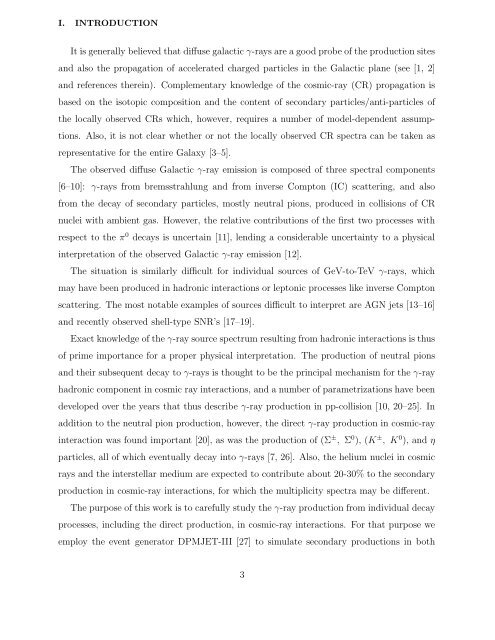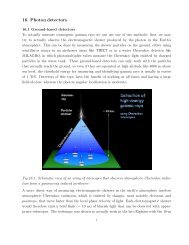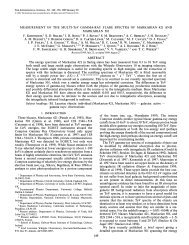Gamma-Rays Produced in Cosmic-Ray Interactions and TeV-band ...
Gamma-Rays Produced in Cosmic-Ray Interactions and TeV-band ...
Gamma-Rays Produced in Cosmic-Ray Interactions and TeV-band ...
Create successful ePaper yourself
Turn your PDF publications into a flip-book with our unique Google optimized e-Paper software.
I. INTRODUCTION<br />
It is generally believed that diffuse galactic γ-rays are a good probe of the production sites<br />
<strong>and</strong> also the propagation of accelerated charged particles <strong>in</strong> the Galactic plane (see [1, 2]<br />
<strong>and</strong> references there<strong>in</strong>). Complementary knowledge of the cosmic-ray (CR) propagation is<br />
based on the isotopic composition <strong>and</strong> the content of secondary particles/anti-particles of<br />
the locally observed CRs which, however, requires a number of model-dependent assumptions.<br />
Also, it is not clear whether or not the locally observed CR spectra can be taken as<br />
representative for the entire Galaxy [3–5].<br />
The observed diffuse Galactic γ-ray emission is composed of three spectral components<br />
[6–10]: γ-rays from bremsstrahlung <strong>and</strong> from <strong>in</strong>verse Compton (IC) scatter<strong>in</strong>g, <strong>and</strong> also<br />
from the decay of secondary particles, mostly neutral pions, produced <strong>in</strong> collisions of CR<br />
nuclei with ambient gas. However, the relative contributions of the first two processes with<br />
respect to the π 0 decays is uncerta<strong>in</strong> [11], lend<strong>in</strong>g a considerable uncerta<strong>in</strong>ty to a physical<br />
<strong>in</strong>terpretation of the observed Galactic γ-ray emission [12].<br />
The situation is similarly difficult for <strong>in</strong>dividual sources of GeV-to-<strong>TeV</strong> γ-rays, which<br />
may have been produced <strong>in</strong> hadronic <strong>in</strong>teractions or leptonic processes like <strong>in</strong>verse Compton<br />
scatter<strong>in</strong>g. The most notable examples of sources difficult to <strong>in</strong>terpret are AGN jets [13–16]<br />
<strong>and</strong> recently observed shell-type SNR’s [17–19].<br />
Exact knowledge of the γ-ray source spectrum result<strong>in</strong>g from hadronic <strong>in</strong>teractions is thus<br />
of prime importance for a proper physical <strong>in</strong>terpretation. The production of neutral pions<br />
<strong>and</strong> their subsequent decay to γ-rays is thought to be the pr<strong>in</strong>cipal mechanism for the γ-ray<br />
hadronic component <strong>in</strong> cosmic ray <strong>in</strong>teractions, <strong>and</strong> a number of parametrizations have been<br />
developed over the years that thus describe γ-ray production <strong>in</strong> pp-collision [10, 20–25]. In<br />
addition to the neutral pion production, however, the direct γ-ray production <strong>in</strong> cosmic-ray<br />
<strong>in</strong>teraction was found important [20], as was the production of (Σ ± , Σ 0 ), (K ± , K 0 ), <strong>and</strong> η<br />
particles, all of which eventually decay <strong>in</strong>to γ-rays [7, 26]. Also, the helium nuclei <strong>in</strong> cosmic<br />
rays <strong>and</strong> the <strong>in</strong>terstellar medium are expected to contribute about 20-30% to the secondary<br />
production <strong>in</strong> cosmic-ray <strong>in</strong>teractions, for which the multiplicity spectra may be different.<br />
The purpose of this work is to carefully study the γ-ray production from <strong>in</strong>dividual decay<br />
processes, <strong>in</strong>clud<strong>in</strong>g the direct production, <strong>in</strong> cosmic-ray <strong>in</strong>teractions. For that purpose we<br />
employ the event generator DPMJET-III [27] to simulate secondary productions <strong>in</strong> both<br />
3







